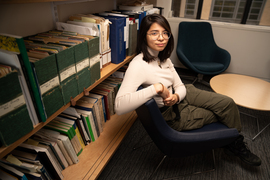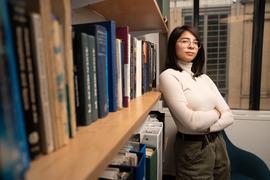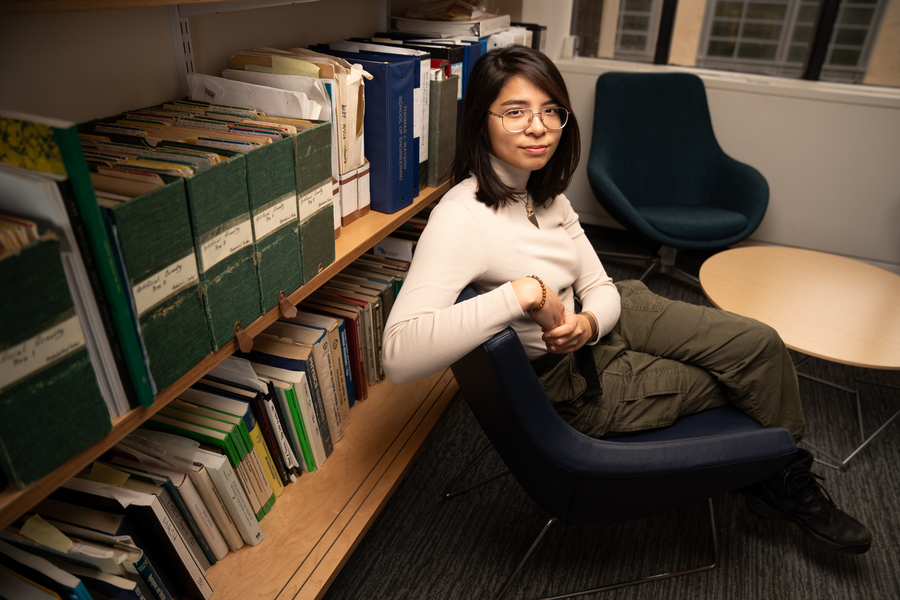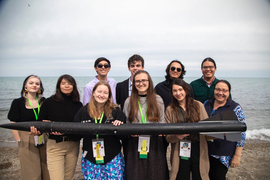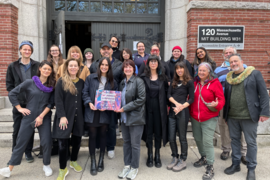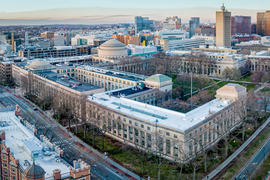What do meteor showers, medicine, and MIT have in common? Aerospace engineering major Nicole McGaa.
The senior has long been drawn to both space and medicine. Growing up in Pittsburgh, Pennsylvania, she would search for good hillsides for watching meteor showers with her brother and father. Meanwhile, her favorite TV shows featured doctors and healers as main characters. The “Star Trek” series was a particular favorite, not just for characters like the physician Beverly Crusher but also for its scientific subject matter and diverse cast.
“I saw space as a place that was open for possibilities. The fact that ‘Star Trek’ is in a space setting is what invites people to think about what the future will be like and if it will it be better,” McGaa says. “Can we use space as a catalyst to make society more equitable?”
When it came time to choose a path after high school, McGaa says, “I thought, ‘Space and medicine are the two things that I really enjoy, I'll pick one of them eventually.’ But I got to MIT, and I realized by fate that MIT was one of the few places in the world that did space medicine, and things took off from there.”
McGaa’s research in bioastronautics, which is the study of biological systems in space, centers around making space travel safer for human bodies and minds. In the future, she envisions herself working with astronauts in a clinical setting, researching and characterizing the physiological impacts of spaceflight and creating countermeasures for such effects through physical, mechanical, or pharmaceutical solutions.
Emergency medicine
McGaa credits her time as a certified EMT with MIT Emergency Medical Services for guiding her path in bioastronautics and giving her the clinical perspective necessary for her work. “Space medicine is very much tied to emergency medicine,” she explains. “A lot of the people who first did space medicine then work in the ER, and many continue to this day to do both. It’s been good for me to help people directly while I'm also trying to help people at a more aspirational level through space.”
McGaa joined MIT EMS during her first year at the Institute, inspired by the kindness and care she received from an ER nurse in her past. As an EMT, she wished to provide such compassion for others, or, better yet, help them avoid medical emergencies completely.
Participating in MIT EMS is one of the most rewarding things she’s done at MIT, according to McGaa. She says responding to emergency calls on campus and throughout Boston and Cambridge, and learning how to provide care alongside other passionate volunteers has been invaluable to her life goals as a medical provider.
Indigenous science
Indigenous representation at MIT and in the scientific community at large is significant to McGaa, who is Oglala Lakota. With the Native American and Indigenous Association, of which she is now the co-president, she has worked to advance initiatives supporting Indigenous people at the Institute, through efforts such as establishing the Indigenous Peoples’ Center, revising MIT’s land acknowledgment, and successfully advocating for the hiring of MIT’s first tenure-track Native American professor.
McGaa continues to work on expanding inclusionary measures for Native students on campus. She is seeking approval for a smudging policy that would allow Indigenous students to engage in the religious practice of burning sage in select areas. Creating a space for students to participate in cultural traditions that they have been historically deprived of is an important way to promote community, according to McGaa, “Native students are, like me, trying to understand and reconnect with our traditions and culture. My generation is really trying to decolonize our identities to heal the kind of pain that our parents and grandparents went through.”
Last year, McGaa assembled an Indigenous rocketry team for First Nations Launch, a national competition in which students compete through designing, building, and launching a high-powered rocket. This was MIT’s first time sending a team, and McGaa headed the project as captain, elected by her peers.
Out-of-this-world research
The bioastronautics field offers a broad array of research topics. McGaa’s focus is on understanding the physiology of astronauts and designing countermeasures for the effects of space exploration that could be useful for people on Earth as well.
With graduate student Rachel Bellisle and Professor and Media Lab Director Dava Newman, McGaa has worked on MIT’s Gravity Loading Countermeasure Skinsuit, which helps astronauts avoid muscle and bone loss during duration spaceflight. This research aligns with McGaa’s overall goal to address different “physiological detriments” caused by space. She also hopes to study spaceflight-associated neuro-ocular syndrome, or SANS, a poorly understood condition that involves the brain and eye changes that impact astronauts. She plans to make this the focus of her studies moving forward, in a PhD program, likely followed by an MD degree.
As an undergraduate, McGaa also interned at the NASA Neil A. Armstrong Flight Research Center with Northrop Grumman Co. where she worked in test flight. And last summer, she worked at Blue Origin in fault management and systems autonomy in aerospace engineering. Noting the contrast between the longstanding government agency and the much newer company, she credited these experiences with strengthening her discipline and initiative, respectively.
To McGaa, all the areas she has explored at MIT, while seemingly varied, fall together in a cohesive way. “Emergency medicine, Indigenous science and advocacy, and space medicine, all connect to my Indigenous values, of excellence in engineering, and caretaking, and community,” she says. Making conditions better for humans in space, the “most hostile environment possible,” will translate to benefits for humanity on Earth as well. “The whole point of going to space is to solve hard things,” she says. “Space is not just for operational drive, it’s clearly for inspirational ambition, as well.”
